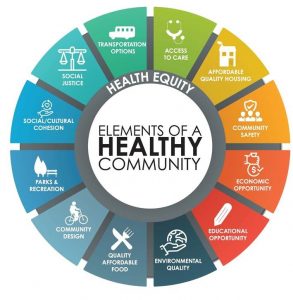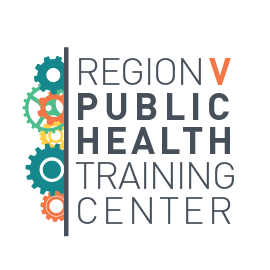By Marissa Byers, Health by Design and Indiana Public Health Association
Photo Credit: Nathan Miller, Fort Wayne Intersection Project by the Fort Wayne Active Transportation Coalition, another Indiana active living organization.
Redlining. Highway expansion. Gentrification. Traffic safety. What do these built environment issues have to do with working towards equity in public health?
The short answer is, everything. Neighborhood and the built environment are social determinants of health that have individual and generational impacts on marginalized communities. The RVPHTC invited Health by Design, a non-profit based in Indianapolis, IN, to share more about the relationship between the built environment and health equity. Health by Design also has a management agreement with the Indiana Public Health Association (IPHA).
Health by Design works at the intersection of the built environment and public health. We address local and statewide concerns about health equity in active living issues such as walking, biking, transit, and land use. Using policy, systems, and environmental change strategies, we work with a coalition of diverse organizations throughout Indiana to impact individual, population, and community health.

Elements of a Healthy Community Diagram. Image created by Alison Redenz, using the model from the Vitalyst Health Foundation.
As public health professionals, we know that zip codes can determine more about health than genetics. In the United States, much of the negative influence on health comes from historic, intentional practices like segregation, redlining, highway expansion, environmental racism, and disinvestment in parks and green spaces. Asthma, high blood pressure, diabetes, and exposure to heavy metals and other pollutants are all physical health impacts that can be linked to these built environment issues. Not only do we see these negative health outcomes in disenfranchised communities, but obstacles for preventative care also arise.
Active living (a way of life that integrates physical activity into daily routines) is not possible in communities where there is no safe infrastructure, where daily trips and destinations require a car, or where backyards are haunted by nearby highway noise and air pollution. In 2018, Health by Design and IPHA convened the Indiana Health Equity Action Team (HEAT), which brings together community members and partners to build awareness, understanding, capacity and ability to address health equity. Guided by a leadership team with representatives from different organizations, HEAT meets every month to expand our understanding of and plan for health equity in Indiana. (Learn more about our active living work via this 2020 training with the RVPHTC.)
Transformational systems change requires us to not only examine the environment around us, but to reshape how we work as organizations. Looking within, we conducted internal equity assessments for both Health by Design and the Indiana Public Health Association with the help of our Boards, staff, and partners. We also built health equity goals into our Strategic Plan Update to make sure we continue to prioritize this work into the future.
No matter where you live, there are elements that streets everywhere should have in order to promote safe, accessible infrastructure for all road users, no matter your zip code or whether you walk, bike, or roll.
Both public health professionals and organizations can take action to promote health equity in your state, city, or even neighborhood:
- You can research if your neighborhood has a homeowners association or neighborhood association and stay up to date about actions at the neighborhood level.
- You can subscribe to updates from your local Department of Public Works and state Department of Transportation to become informed about current built environment projects and monitor potential public health impacts.
- Both individuals and organizations can participate in the public input process at the local, state, and national level to influence built environment plans, policies, and projects.
- Organizations can conduct an equity assessment to make sure their internal and external processes are accessible, equitable, and inclusive.
- Groups can work to influence decision makers (in their own or other organizations) to include policy, systems, and environmental approaches to create change for health equity.
Interested in taking action? Contact Health by Design at [email protected] for further guidance and support.

